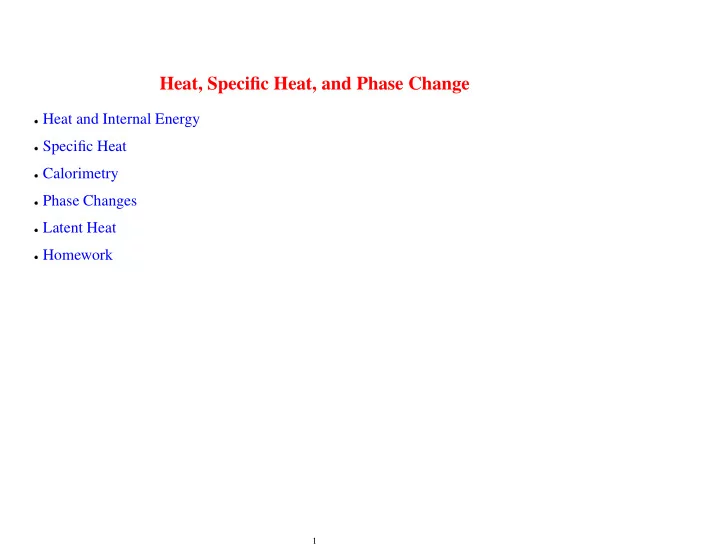

� � � � � � Heat, Specific Heat, and Phase Change Heat and Internal Energy Specific Heat Calorimetry Phase Changes Latent Heat Homework 1
� ✆ � ✂ ☞ � ✄☎ ✁ ✁ ✌✍✎ ✝ ✞✟ ✂ � ✠✡ ☛ � Heat and Internal Energy Heat is the energy transferred between a system and its environment because of a tempera- ture difference between them. Before scientists realized that heat is transferred energy, they measured heat in a unit called the calorie (cal), defined as the heat required to raise the temperature of 1 g of water from 14.5 C to 15.5 C. In 1948, the scientific community decided that since heat (like work) is transferred energy, the SI unit for heat should be the joule (J). The relationship between the calorie and the joule is known as the mechanical equivalent of heat and is given by Internal energy is the energy associated with the microscopic components of a system - the atoms and molecules 2
✔ � ✤ ✏ ✖ ✑ ✓ ✒ ✒✓ ✑✕ ✏ Specific Heat The heat transferred between a system of mass and its surroundings when the system undergoes a temperature change is given by where c is the specific heat of the system. The SI units of specific heat are . ✚✜✛✣✢ ✗✙✘ 3
✫ ✭ ✧ ✔ ★ � � ✑ ✩ ✓ ✧ ✩ ✓ ✢ ✢ ✬ ✑ ✪ ✓ ✒✓ ✕ ✑ ✧ ✏ ✥ ✦ ✏ ✧ ✔ ★ ✑ ✥ ✕ ✥ ✒✓ ✥ ✦ ✑ Calorimetry When two objects at different temperatures are placed in thermal contact and are insulated from their sur- roundings, the principle of conservation of energy requires that Example 1 - A copper slug whose mass is 0.0750 kg is heated in a laboratory oven to a temperature of 312 C. The slug is then dropped into a glass beaker containing a mass = 0.220 kg of water. The mass of the glass beaker is = 0.225 kg. The initial temperature of the water and beaker is 12.0 C. Assuming that the slug, water, and beaker are an isolated system and the water does not vaporize, find the final temperature of the system at equilibrium. 4
� ✢ ✢ � � Phase Changes Shown below is a graph of temperature versus heat added when 1 g of ice initially at -30 C is converted to steam at 120 C. Notice that the temperature doesn’t necessarily have to change as heat is transferred to the system Instead, the substance can undergo a phase change 5
✭ ✯ ✯ ✰ ✏ � ✯ ✯ ✑ ✮ ✔ ✏ ✑ Latent Heat The heat required to change the phase of a mass of a pure substance is is called the latent heat and depends on the type of phase change and the substance – – The sign is determined by the direction of the heat flow - is positive if energy is added to the substance and negative if it is removed – The heat of fusion is the heat absorbed per kg in a solid-to-liquid conversion – The heat of vaporization is the heat absorbed in a liquid-to-vapor conversion 6
✁ ✁ ✁ Example 2 Four ice cubes at 0.0 C, each of mass 0.0400 kg, are dropped into a 0.0500 kg glass containing 0.300 kg of water at 30.0 C. What is the mass of ice left when the water and glass have cooled to 0.0 C? 7
� � � Homework Set 4 - Due Fri. Jan. 16 Read Sections 17.1 - 17.3 Answer Questions 17.1, 17.4 & 17.10 Do Problems 17.1, 17.6, 17.11 & 17.15 8
Recommend
More recommend